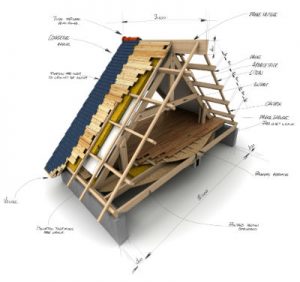How To Build a Resilient Dwelling
If you are considering re-roofing your house yourself then you should definitely think long and hard before actually starting. The reason is the work itself is extremely difficult not only physically but technically as well. However, in this article I’m going to talk you through the difference that you need to take if you want to attempt it. I would always urge you to consider getting a professional roofing contractor to do the job if you can.
 One of the things you need to consider is whether or not you need to get a permit to do the work. If you’re changing the structure of the roof, then more than likely need planning permission but in some areas you may need to get a permit because of the health and safety aspect. If you are in a terraced house, then you may well need to take certain precautions such as roping off sidewalks to make sure you protecting passers-by from any potential falling objects.
One of the things you need to consider is whether or not you need to get a permit to do the work. If you’re changing the structure of the roof, then more than likely need planning permission but in some areas you may need to get a permit because of the health and safety aspect. If you are in a terraced house, then you may well need to take certain precautions such as roping off sidewalks to make sure you protecting passers-by from any potential falling objects.
On this website you can find anything you need to know to do the roofing step by step. There may be a case where you can do a certain amount of work yourself but may need a professional finish off the more difficult tasks.
Reroofing your house is something you should try and do in the warmer months as rainfall, snow and ice can cause havoc while trying to reroof the house. The main problem here is water can cause damage before you’ve even relayed a roof. If you are in a state that is more prone to heavy rainfall and snow, then it was certainly worth installing a under layer on the roof. The under layer will act as a waterproof layer as well as an ice barrier and for the relatively low cost of installing it will save you a lot more money in the long run.
In general, if you purchase high-quality under layer they are self-adhesive and create a tight seal which is perfect for keeping out water. Because the material it is made out of you will be to stick it straight to the roof sheathing and even if you were to put nails through it is designed such that it will seal itself around those nails.
After you put the under layer on you need to cover the rest of the roof in asphalt under layer. When you are laying the asphalt layer you need to make sure that you start at the bottom and as you rise to the top of the roof each layer is overlapping the one below. The asphalt layer keeps the roof decking dry before you lay the shingles on.
The following steps up and talk about will break up into smaller sections which will make it easier few to follow. You can do directly to a particular section by following the navigation bar at the top of the site. While the blog section is not necessarily part of the step by step process we do like to share information and updates which we think you may find useful.
As with anything, if you are unsure of what has been explained, simply contact us and I will try and get back to you with answers as soon as I can.